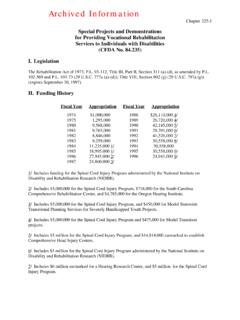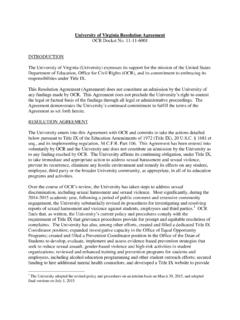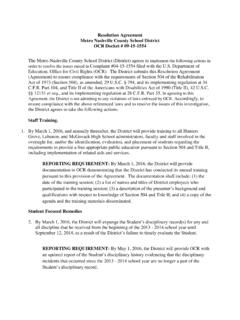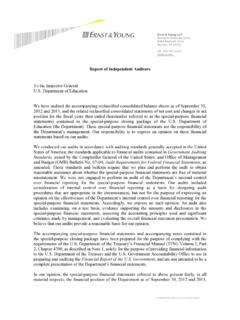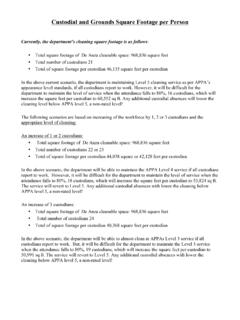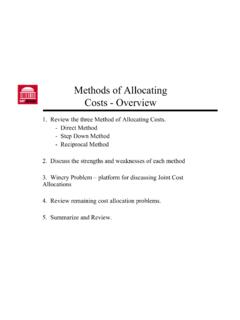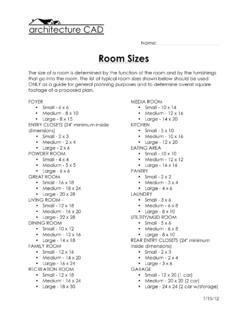Transcription of Model Cost Allocation Plan - ed
1 XYZ COMPANY Model cost Allocation Plan Use the following Model cost Allocation Plan (CAP) as guidance for Non-profit organizations. The CAP should be tailored to fit the specific policies of each organization. If your organization s policies are different in any of the categories, please specifically identify the methodology used. Although there are different methodologies available for allocating costs, the methodology used should result in an equitable distribution of costs to programs. Recipients must have a system in place to equitably charge costs.
2 Additionally, as required by Office of Management and Budget Circular A-122, time distribution records must reflect an after-the-fact determination of the actual activity of each employee. Considerations in determining an appropriate base for allocating costs include the relative benefits received, the materiality of the cost , and the amount of time and cost to perform the Allocation . XYZ COMPANY cost Allocation PLAN Purpose/General Statements The purpose of this cost Allocation plan is to summarize, in writing, the methods and procedures that this organization will use to allocate costs to various programs, grants, contracts and agreements.
3 OMB Circular A-122, cost Principles for Non-Profit Organizations, establishes the principles for determining costs of grants, contracts and other agreements with the Federal Government. XYZ Organization s cost Allocation Plan is based on the Direct Allocation method described in OMB Circular A-122. The Direct Allocation Method treats all costs as direct costs except general administration and general expenses. Direct costs are those that can be identified specifically with a particular final cost objective. Indirect costs are those that have been incurred for common or joint objectives and cannot be readily identified with a particular final cost objective.
4 Only costs that are allowable, in accordance with the cost principles, will be allocated to benefiting programs by XYZ Organization. General Approach The general approach of XYZ Organization in allocating costs to particular grants and contracts is as follows: A. All allowable direct costs are charged directly to programs, grants, activity, etc. B. Allowable direct costs that can be identified to more than one program are prorated individually as direct costs using a base most appropriate to the particular cost being prorated. C. All other allowable general and administrative costs (costs that benefit all programs and cannot be identified to a specific program) are allocated to programs, grants, etc.
5 Using a base that results in an equitable distribution. Allocation OF COSTS The following information summarizes the procedures that will be used by XYZ Organization beginning Month/Day/Year: A. Compensation for Personal Services - Documented with timesheets showing time distribution for all employees and allocated based on time spent on each program or grant. Salaries and wages are charged directly to the program for which work has been done. Costs that benefit more than one program will be allocated to those programs based on the ratio of each program s salaries to the total of such salaries (see Example 1).
6 Costs that benefit all programs will be allocated based on the ratio of each program s salaries to total salaries (see example 2). 1. Fringe benefits (FICA, UC, and Worker s Compensation) are allocated in the same manner as salaries and wages. Health insurance, dental insurance, life & disability and other fringe benefits are also allocated in the same manner as salaries and wages. 2. Vacation, holiday, and sick pay are allocated in the same manner as salaries and wages. B. Travel Costs - Allocated based on purpose of travel. All travel costs (local and out-of-town) are charged directly to the program for which the travel was incurred.
7 Travel costs that benefit more than one program will be allocated to those programs based on the ratio of each program s salaries to the total of such salaries (see Example 1). Travel costs that benefit all programs will be allocated based on the ratio of each program s salaries to total salaries (see Example 2). C. Professional Services Costs (such as consultants, accounting and auditing services) - Allocated to the program benefiting from the service. All professional service costs are charged directly to the program for which the service was incurred. Costs that benefit more than one program will be allocated to those programs based on the ratio of each program s expenses to the total of such expenses (see Example 3).
8 Costs that benefit all programs will be allocated based on the ratio of each program s expenses to total expenses (see Example 4). D. Office Expense and Supplies (including office supplies and postage) - Allocated based on usage. Expenses used for a specific program will be charged directly to that program. Postage expenses are charged directly to programs to the extent possible. Costs that benefit more than one program will be allocated to those programs based on the ratio of each program s expenses to the total of such expenses (see Example 3). Costs that benefit all programs will be allocated based on the ratio of each program s expenses to total expenses (see Example 4).
9 E. Equipment - XYZ Organization depreciates equipment when the initial acquisition cost exceeds $x,xxx. Items below $x,xxx are reflected in the supplies category and expensed in the current year. Unless allowed by the awarding agency, equipment purchases are recovered through depreciation. Depreciation costs for allowable equipment used solely by one program are charged directly to the program using the equipment. If more than one program uses the equipment, then an Allocation of the depreciation costs will be based on the ratio of each program s expenses to the total of such expenses (see example 3).
10 Costs that benefit all programs will be allocated based on the ratio of each program s expenses to total expenses (see example 4). F. Printing (including supplies, maintenance and repair) - Expenses are charged directly to programs that benefit from the service. Expenses that benefit more than one program are allocated based the ratio of the costs to total expenses. Costs that benefit more than one program will be allocated to those programs based on the ratio of each program s expenses to the total of such expenses (see example 3). Costs that benefit all programs will be allocated based on the ratio of each program s expenses to total expenses (see example 4).

